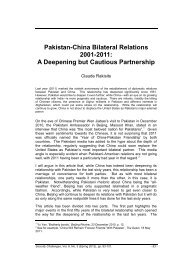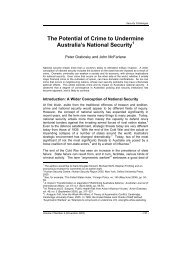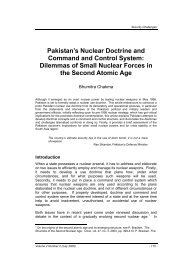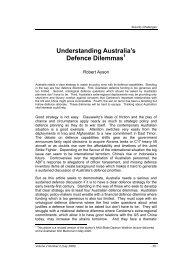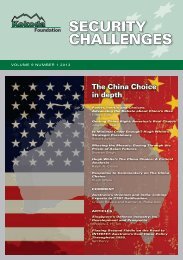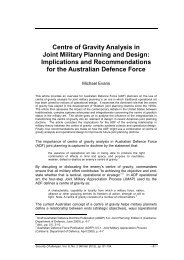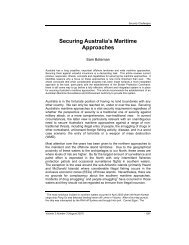The Transformation of Triad - Security Challenges
The Transformation of Triad - Security Challenges
The Transformation of Triad - Security Challenges
Create successful ePaper yourself
Turn your PDF publications into a flip-book with our unique Google optimized e-Paper software.
Roderic Broadhurst and Lee King Wa<br />
operation through Xiamen ports was investigated by the Chinese Communist<br />
Party (CCP) Central Commission for Discipline Inspection and was<br />
estimated to have cost the state revenue <strong>of</strong> $US3.6 billion in lost import<br />
duties (between 1994-1999) and involved as many as 200 corrupt <strong>of</strong>ficials<br />
including provincial, bureau and departmental heads. 49 <strong>The</strong> scale and scope<br />
<strong>of</strong> some <strong>of</strong> these criminal activities have presented Chinese Public <strong>Security</strong><br />
and People’s Court <strong>of</strong>ficials with immense challenges, 50 heightened<br />
concerns about the influence <strong>of</strong> foreign criminals and hastened the need to<br />
foster mutual assistance with foreign police services. 51<br />
We <strong>of</strong>fer a brief overview <strong>of</strong> HK triad-related ‘dark’ societies and theories<br />
about the role <strong>of</strong> lethal violence in organised crime. <strong>The</strong> nexus between<br />
triads and organised crime is made partly visible by extreme violence. Our<br />
analysis <strong>of</strong> triad-related homicide cases are drawn from the HK Homicide<br />
Monitoring Database (HKHMD 52 ) and described by Lee, Broadhurst and<br />
Beh, 53 Lee 54 and Lee, Broadhurst and Beh 55 for the period 1989-1998 and<br />
preliminary data derived from the updated HKHMD 1989-2005. We discuss<br />
the impact <strong>of</strong> periodic suppression, new countermeasures and the likely<br />
detained; X.W. Wang, ‘Power, sex and money: the recipe for corruption’ South China Morning<br />
Post, 4 May, 2009, p. 5.<br />
49<br />
S. Li, ‘<strong>The</strong> Centre’s Scrutiny Elasticity and the Local’s Response: <strong>The</strong> Anti-smuggling<br />
Campaign in Xiamen, 1991-2001’, in R. G. Broadhurst (ed.), Crime and its Control in the<br />
People’s Republic <strong>of</strong> China: Proceedings <strong>of</strong> the University <strong>of</strong> Hong Kong Annual Symposia<br />
2000-2002 (Hong Kong: Centre for Criminology, <strong>The</strong> University <strong>of</strong> Hong Kong, 2004), pp 164-<br />
85; and S. Shieh, '<strong>The</strong> Rise <strong>of</strong> Collective Corruption in China: <strong>The</strong> Xiamen Smuggling Case';<br />
Chin and Godson, ‘Organized Crime and the Political–Criminal Nexus in China’.<br />
50<br />
Over a million ‘black society’ members were estimated to be active in 2000 in China; see S.<br />
Cai, ‘Anti-Corruption should be done before Anti-Secret Societies’, China News Weekly, 23<br />
September 2000, pp. 21-2; C.Y. Choi, ‘<strong>Triad</strong> invasion growing, says Guangdong court’, South<br />
China Morning Post, 5 September, 2007, p. 1, cited Guangdong People’s Higher Court<br />
spokesman Chen Cao who referred to the ‘obvious infiltration <strong>of</strong> overseas groups’. <strong>The</strong><br />
‘Heavenly Way’ (in Cantonese Tian Lin Hui) perhaps related to the well known Taiwanese<br />
‘Celestial Alliance’ (Tien Dao Mun in Mandarin) was identified as the main triad by the court.<br />
51<br />
S. Liao, J. Luo and W. Wen, ‘Anti-<strong>Triad</strong> Society Activities Should Be Strengthened and<br />
Deepened’, China Criminal Police, vol. 11, no. 3 (1999), pp. 27-32; X. Zhou and X. Liu, ‘Review<br />
<strong>of</strong> the 2001 Guangdong Crackdown on Organized Crime—Seminar’, Public <strong>Security</strong> Research,<br />
vol. 2 (2002), pp. 77-83; Y. Xie and Y. Wang, ‘Research on Organized Crime: Ten-Year Review,<br />
Evaluation and Prospect’, Journal <strong>of</strong> Crime Research, vol. 3 (2005), pp. 19-35 (all in Chinese).<br />
52<br />
R. Broadhurst, ‘<strong>The</strong> Hong Kong Homicide Monitoring Data Base’, 1st Annual Conference <strong>of</strong><br />
the Hong Kong Sociology Association, <strong>The</strong> University <strong>of</strong> Hong Kong, 12 December 1999,<br />
[Accessed 9 May 2009].<br />
53<br />
K. W. Lee, R. Broadhurst and S. L. Beh, ‘<strong>Triad</strong> Related Homicide in Hong Kong 1989–1998: A<br />
Preliminary Description’, in Broadhurst (ed.), Crime and its Control in the People’s Republic <strong>of</strong><br />
China, pp. 263-87.<br />
54<br />
K. W. Lee, ‘<strong>Triad</strong>-related Homicide 1989–1998’, PhD thesis, Hong Kong, University <strong>of</strong> Hong<br />
Kong, 2005.<br />
55<br />
K. W. Lee, R. G. Broadhurst and S. L. Beh, ‘<strong>Triad</strong>–Related Homicides in Hong Kong’,<br />
Forensic Science International, vol. 162 (2006), pp. 183-90; data for homicide generally and<br />
triad-related murder in HK has been extended to 1989–2005 and work is currently in<br />
preparation, however, some summary data is available up to 2005.<br />
- 8 - <strong>Security</strong> <strong>Challenges</strong>



